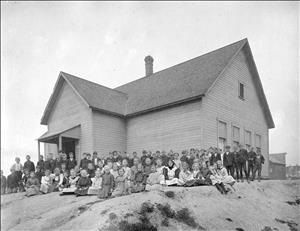This history of Adams Elementary School is taken from the second edition of Building for Learning: Seattle Public School Histories, which includes histories of every school building used by the district since its formation around 1862. The original essay was written for the 2002 first edition by Nile Thompson and Carolyn J. Marr, and updated in 2023 by HistoryLink contributor Rita Cipalla.
Adams Elementary School
In 1889 the community of Ballard was so small that the new school at its west end was simply called the Ballard School. Around 1901, the name was changed to Broadway School as Ballard School District No. 50 by then had a second school. At some point before September 1907, the Broadway School building was enlarged to four classrooms. When Ballard became part of the City of Seattle and Broadway Street was renamed Market Street to avoid confusion with the other Broadway on Capitol Hill, some people began to refer to Broadway School as the Market Street School.
A replacement school, opened in 1909, was built on a larger site a few blocks to the north. Named Adams School, it was not desig- nated which of the patriots of the famous Massachusetts family it honored. While little Broadway School had only four teachers and 150 students in grades 1-6, the new Jacobean-style building opened with 13 teachers and 500 students in grades 1-8. Also incorporated into Adams were the students of Cleek School, located since 1903 in a rented building at what is now 22nd Avenue NW and NW 57th Street (site of a former Safeway grocery store). The 1889 Broadway schoolhouse served as a gym for Ballard High School from 1912-1916. This site was sold in 1924 to Vasa, a Swedish-Finn fraternal organization. The building served as Vasa Hall until 1938. The property was sold again and cleared to make way for a gas station.
Ballard Pride
The new building was a source of pride for the Ballard community. The site had been purchased jointly with the Seattle Parks Department so the school would be adjacent to a public playfield and fieldhouse. James Stephen, Seattle schools district architect, designed the building according to his “model school” plan, with a central core of nine rooms linked to an eight-room wing. The building typified the Jacobean style, popular for both public and residential structures in this period, with a steeply pitched roof, narrow windows, and red brick facing with terra cotta ornamentation. After the grounds were leveled and the fieldhouse completed in spring 1910, Arthur G. Sears, the first principal, held Arbor Day exercises. Older schoolboys went into the nearby woods and brought back small trees, which were planted around the block. Each class planted a tree and named it for a famous American. Some of these trees are still on the grounds.
Adams was selected by the district in 1911, along with Mercer and Summit, to introduce an industrial arts program for 7th and 8th graders. Children from other schools transferred to Adams for this program, which was so successful that six additional schools (Columbia, Georgetown, Green Lake, Latona, Longfellow, and Washington) offered it the following year.
A kindergarten class began in 1928 when enrollment reached 741 pupils. In fall 1931, the 7th and 8th graders moved to James Monroe Junior High School. As a K-6 elementary school, Adams grew to exceed its capacity in the 1950s, enrolling between 850 and 950 students. In 1971, an addition opened on the northwest corner of the building, containing a gymnasium, learning resource center, team teaching area, and offices. As part of a Seattle School District major capital improvement bond passed in February 1984, a new Adams School was designed to replace the 1909 structure and incorporate the 1971 addition. Demolition was recommended because of the building’s susceptibility to earthquake damage. A group of community members proposed saving the old building and converting it into artists’ studios and residences. Their plan was rejected in August 1987 by school board members who cited the need for playground space and the unsafe nature of the building. Contractors salvaged parts of the terra cotta ornamentation to use on the new construction and the PTA sold bricks from the old school to fund preservation of the east entry. The new construction, supplementing the 1971 addition, is a two-story masonry and concrete structure with 20 classrooms. During the 1987-1988 school year, Adams students were temporarily housed at Magnolia School. The present school has a different street orientation than before on 28th Avenue NW, behind a grove of mature American sycamores.
In 2017, a $500,000 energy efficiency grant from the Office of Superintendent of Public Instruction helped fund a geothermal well field and new energy-efficient water-source heat pump. Eighty wells were drilled, each some 350 feet deep. The water that circulates through underground pipes warms the building in the winter and cools it in the warmer months.
History
Ballard School
Location: NW corner of Broadway (NW Market Street) and 4th Avenue (24th NW)
Building: 2-room wood
Architect: n.a.
Site: 2.3 acre
1889: Opened by Ballard School District ca. 1901: Renamed Broadway School
1907: Annexed into Seattle School District
1909: Closed in December
1912-16: Gym for Ballard
High School
1924: Building and site sold
1938-39: Building removed or demolished
Present: Site of a Texaco gas station
Adams School
Location: 6129 26th Avenue NW
Building: 17-room, 2-story brick
Architect: James Stephen
Site: 1.64 acres
1909: Named on April 7
1910: Opened on January 3
1971: Addition (Stoddard & Huggard) opened in March
1987: Temporarily closed in June; 1910 structure demolished
1989: Addition (Miller/Hull & Bogard); site expanded to 3.4 acres; reopened in September
2017: Geothermal wells and heat pump; seismic updates
Adams Elementary in 2023
Enrollment: 428
Address: 6110 28th Avenue NW
Nickname: Eagles
Configuration: K-5
Colors: Green and white

